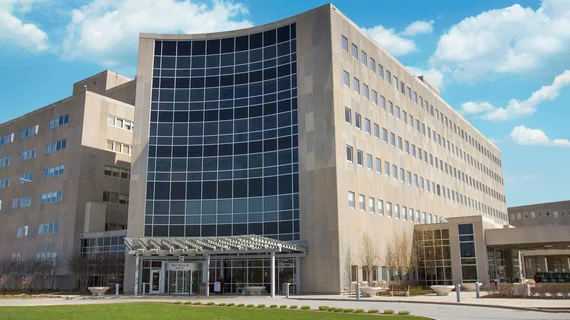‘Your heart belongs here’: Improved device, economics help cardiologists keep more patients close to home
Munster, Indiana, is a thriving suburb 30 miles south of the heart of Chicago. It’s a place where the locals like to stay local, especially when it comes to healthcare.
Patients in the area often turn to 454-bed Community Hospital, one of three acute-care hospitals part of Powers Health. “We have personal relationships with our patients that you just don’t see at the large academic centers,” says Samer Abbas, MD, an interventional cardiologist and Powers Health’s medical director of cardiac catheterization. “We know these patients. We’ve treated their parents. We have the exact same technology as those bigger facilities, and we have had just as much training. We develop these lasting relationships that make a big difference on patient care.”
One of the many leading-edge technologies making a difference for patients at Powers Health is the Shockwave Coronary Intravascular Lithotripsy (IVL) device from Shockwave Medical. This first-of-its-kind catheter uses sonic pressure waves to crack calcium within coronary arteries prior to stent placement. Fracturing the calcium enhances stent expansion.
Community Hospital was an early adopter when IVL first launched in 2021 due to the pre-disposition of coronary artery disease within the patient population of Powers Health. Abbas and his fellow cardiologists appreciated how coronary IVL’s uniquely designed mechanism of action combines effective modification of all types of calcium—superficial or deep, concentric, eccentric or nodular — with the ability to preserve healthy tissue all within an intuitive, balloon-based platform.
Improved catheter takes PCI performance to the next level
The team was pleased with the outcomes they were seeing with IVL, but there was some hesitancy in considering IVL as a therapy option within longer lesions and challenging, “boulder-like” calcium morphologies.
Good news came in late 2023 when Shockwave launched the next-gen coronary IVL catheter -Shockwave C2+ which provides operators like Abbas and his partner Dean Ferrera, DO with 50% more therapy “pulses” per catheter as compared to Shockwave C2 – Shockwave’s legacy coronary catheter. The additional pulses are combined with other improvements to streamline system set up.

“Now that the catheter is more efficient, I know I’m using IVL even more than I did in the past. The additional pulses pair nicely with the known safety and intuitive benefits of IVL in longer lesions, making these traditionally complex lesions less complex. I feel confident that those longer segments of disease will be much easier to go after.”
Dean Ferrara, DO, Interventional Cardiologist, Powers Health, Munster, Indiana
Indeed, gaining 50% more pulses has represented a significant improvement in scope of treatment. Hesitancy to consider IVL within longer lesions and boulder-like calcium at Powers Health has waned since the team started using C2+.
“Now that the catheter is more efficient, I know I’m using IVL even more than I did in the past,” Ferrera says. “The additional pulses pair nicely with the known safety and intuitive benefits of IVL in longer lesions, making these traditionally complex lesions less complex. I feel confident that those longer segments of disease will be much easier to go after.”
Ferrera adds that C2+ allows cardiologists to better treat boulder-like calcium morphologies – more namely nodular and eccentric calcium – with IVL.
“We were all going after circumferential calcium at first with IVL, but now we can even proceed when there are chunks of calcium that we know are going to take additional pulses,” he says. “The additional pulses provide more ‘shots on goal’ to modify these traditionally hard-to-treat calcium morphologies within the lesion.”
Abbas agrees, adding that the upgrade has cemented Shockwave’s place as a must-have tool for all interventional cardiologists who perform PCI.
“This is one of those essential tools that every cath lab in this country should have,” he says. “There’s no question in my mind. There are lot of calcium modification tools out there, and we have used them all. Many of them are interchangeable. But now that Shockwave produced this new catheter, making it so we rarely have to take the balloon out and replace it with another balloon, there are no limitations to what it can do. It continues to be our preferred calcium modification strategy for balloon crossable, calcified lesions.”
Evolved economics renumerates cardiologists and covers costs
The good news on the technology front was quickly followed by positive news on the reimbursement front for cardiologists and administrators at Powers Health.
As Abbas and Ferrera recall, the early economics of coronary IVL were a subject of conversation throughout the cardiology department due to a premium priced product with little relief coming from the payor space. But that changed in 2023 when the U.S. Centers for Medicare & Medicaid Services (CMS) established new long-term physician and hospital inpatient reimbursement pathways for procedures involving coronary IVL.
On the physician reimbursement front, the 2024 Medicare Physician Fee Schedule from CMS introduced a new add-on Current Procedural Terminology (CPT®) code specifically describing the use of coronary IVL. Effective January 1, 2024, CPT® add-on code +92972 provides operators an additional 2.97 work relative value units (wRVUs) and an additional $140 professional fee in addition to the base procedure when coronary IVL is performed. Prior to the 2024 CMS update, there were no relative value units or professional fees associated with the coronary application of IVL.

“When we first started performing IVL, the lower reimbursements were an issue. We still moved forward with the technology because of how important it was for patient care…It’s such a great technology—every physician and every hospital should be able to use it and receive a proper reimbursement.”
Sameer Abbas, MD, Medical Director of Cardiac Catheterization,
Powers Health, Munster, Indiana
Also, for the first time in decades, CMS established new Medicare Severity Diagnosis Related Group (MS-DRG) codes that describe the use of a new technology in the hospital inpatient setting. The 2024 Medicare Inpatient Prospective Payment System (IPPS) established MS-DRG codes 323, 324 & 325 effective October 1, 2023, which specifically describe the use of coronary IVL. The payments associated with MS-DRG codes 323 and 324 (IVL + stent procedures) provides an incremental payment of ~$8,000 as compared to standard PCI with stent procedures which more than covers the acquisition cost of coronary IVL. Previously, coronary IVL was reimbursed via the temporary New Technology Add-on Payment (NTAP) pathway which provided a max incremental payment of $3,666 for coronary IVL procedures.
For interventional cardiologists and hospitals, the reimbursement changes represent a new reality where coronary IVL can be performed as often as clinically necessary.
“When we first started performing IVL, the lower reimbursements were an issue,” Abbas says. “We still moved forward with the technology because of how important it was for patient care. But the hospital was basically taking a loss each time we used it. It’s such a great technology—every physician and every hospital should be able to use it and receive a proper reimbursement.”
Prior to the reimbursement update, “we used to routinely discuss each and every case, wondering if it was a good fit for IVL. That’s gone by the wayside now that we’re so much more confident in the technology and reimbursement side of things. Now we can use Shockwave whenever we need to, no questions asked.”
The back office changes in reimbursement went smoothly too. Simple and straightforward is how the team at Powers Health describes the implementation of the new billing codes for coronary IVL. The hospital billing and coding team worked alongside Shockwave’s reimbursement team to ensure everyone was on the same page.
“It was a very, very easy process,” Abbas says. “We relayed the news to hospital leadership once we understood the changes and the previous checks and considerations for IVL that were in place were removed.”
Patients stay where they belong
In just a few years, coronary IVL technology has earned its spot as an essential tool across Powers Health’s cath labs. Specialists know that even the most challenging patients can receive the high-quality care they deserve.
“Our cardiologists can now perform PCI on even the most complex patients,” Abbas says. “This means we don’t have to send them off to an academic center in Chicago or anywhere else; we can handle everything ourselves. It’s like I always tell my patients: Your heart belongs here.”
Disclaimers and Important Safety Information:
Drs. Ferrara and Abbas are paid consultants of Shockwave Medical. Views expressed are those of the authors and not necessarily those of Shockwave Medical.
CPT® is a registered trademark of the American Medical Association. Copyright 1995-2024. All rights reserved.
The coding, coverage, and reimbursement information contained herein is gathered from various public resources, is provided for educational purposes only, and is subject to change without notice. Shockwave Medical does not guarantee, represent, or warrant that the information in this guide is accurate or complete. Shockwave Medical also does not guarantee, represent, or warrant success in obtaining third-party insurance coverage or reimbursement from Medicare or any other third-party payer. Third-party coverage and reimbursement for medical products and services is affected by numerous factors. It is always the provider’s responsibility to determine and submit appropriate codes, charges, and modifiers for services that are rendered. Providers should contact their third-party payers for specific information on their coding, coverage, and payment policies, and these policies may vary by third-party payer.
Amounts reflect the base payment rate before adjustments, including any sequestration or geographic adjustments. Payment rates are updated periodically by CMS, and the above information does not represent a guarantee of coverage or reimbursement.
In the United States: Rx only.
Indications for Use— The Shockwave Intravascular Lithotripsy (IVL) System with the Shockwave C2+Coronary IVL Catheter is indicated for lithotripsy-enabled, low-pressure balloon dilatation of severely calcified, stenotic de novo coronary arteries prior to stenting.
Contraindications—The Shockwave C2+ Coronary IVL System is contraindicated for the following: This device is not intended for stent delivery. This device is not intended for use in carotid or cerebrovascular arteries.
Warnings—Use the IVL Generator in accordance with recommended settings as stated in the Operator’s Manual. The risk of a dissection or perforation is increased in severely calcified lesions undergoing percutaneous treatment, including IVL. Appropriate provisional interventions should be readily available. Balloon loss of pressure was associated with a numerical increase in dissection which was not statistically significant and was not associated with MACE. Analysis indicates calcium length is a predictor of dissection and balloon loss of pressure. IVL generates mechanical pulses which may cause atrial or ventricular capture in bradycardic patients. In patients with implantable pacemakers and defibrillators, the asynchronous capture may interact with the sensing capabilities. Monitoring of the electrocardiographic rhythm and continuous arterial pressure during IVL treatment is required. In the event of clinically significant hemodynamic effects, temporarily cease delivery of IVL therapy.
Precautions— Only to be used by physicians trained in angiography and intravascular coronary procedures. Use only the recommended balloon inflation medium. Hydrophilic coating to be wet only with normal saline or water and care must be taken with sharp objects to avoid damage to the hydrophilic coating. Appropriate anticoagulant therapy should be administered by the physician. Precaution should be taken when treating patients with previous stenting within 5mm of target lesion.
Potential adverse effects consistent with standard based cardiac interventions include– Abrupt vessel closure - Allergic reaction to contrast medium, anticoagulant and/or antithrombotic therapy-Aneurysm-Arrhythmia-Arteriovenous fistula-Bleeding complications-Cardiac tamponade or pericardial effusion-Cardiopulmonary arrest-Cerebrovascular accident (CVA)-Coronary artery/vessel occlusion, perforation, rupture or dissection-Coronary artery spasm-Death-Emboli (air, tissue, thrombus or atherosclerotic emboli)-Emergency or non-emergency coronary artery bypass surgery-Emergency or non-emergency percutaneous coronary intervention-Entry site complications-Fracture of the guide wire or failure/malfunction of any component of the device that may or may not lead to device embolism, dissection, serious injury or surgical intervention-Hematoma at the vascular access site(s)-Hemorrhage-Hypertension/Hypotension-Infection/sepsis/fever-Myocardial Infarction-Myocardial Ischemia or unstable angina-Pain-Peripheral Ischemia-Pseudoaneurysm-Renal failure/insufficiency-Restenosis of the treated coronary artery leading to revascularization-Shock/pulmonary edema-Slow flow, no reflow, or abrupt closure of coronary artery-Stroke-Thrombus-Vessel closure, abrupt-Vessel injury requiring surgical repair-Vessel dissection, perforation, rupture, or spasm.
Risks identified as related to the device(s) and its use: Allergic/immunologic reaction to the catheter material(s) or coating-Device malfunction, failure, or balloon loss of pressure leading to device embolism, dissection, serious injury or surgical intervention-Atrial or ventricular extrasystole-Atrial or ventricular capture.
Prior to use, please reference the Instructions for Use for more information on indications, contraindications, warnings, precautions and adverse events. www.shockwavemedical.com/IFU
SPL-71838 Rev. A

